One of the oldest and most widespread crafts in Central Asia is pottery, found across cities and many villages. Its origins trace back to ancient times, and it has persisted through the centuries. In the past, there were renowned centers of pottery whose products were celebrated far beyond the region. Some of the most significant centers included Rishtan in the Ferghana Valley, Gijduvan in Bukhara, and Madir and Bagat in Khorezm. These regions produced high-quality glazed ceramics, known for their delicate and refined patterns. Pottery was also notably developed in Tashkent and Shakhrisabz.
The craft of pottery was so advanced that it saw the establishment of specialized production lines and division of labor for specific items. Each region developed its distinct ornamental styles. For example, artisans from Ferghana specialized in fine, thin-walled earthenware adorned with blue designs over a pale background, often mimicking Chinese porcelain. In Tashkent, they produced glazed pottery with vibrant multicolored patterns on a cream-colored background — especially large plates. Bukhara’s Gijduvan craftsmen produced pottery with a dark brown base, accentuated by intricate patterns in cream, green, and brick-red tones. Khorezm ceramics were known for their unique forms and dense blue-green patterns — especially in the large deep bowls with vertical sides and elevated bases, featuring elaborate plant motifs intertwined with geometric designs.
Beyond plates, Khorezm artisans crafted hums (large floor vessels for water), churns for butter, milk jugs, large mixing bowls, lamps, flowerpots, washing jugs, small baby cradles, and even scooping jugs for waterwheels, alongside occasional children’s toys. For wealthy patrons hosting large gatherings, artisans produced tea bowls and special flat-bottomed bowls, often in quantities reaching several thousand.
Glazed ceramics also found extensive use in architectural decoration in Samarkand, Bukhara, Kokand, and other cities, covering large buildings, mosques, madrasahs, and palaces. The techniques and tools used by master craftsmen in creating decorative glazed bricks and tiles closely paralleled those of potters, though instead of working on individual pieces, these artisans crafted hundreds of bricks, intricately interconnected through numbered patterns. While they didn’t require a pottery wheel, they used kilns for firing, and the same paint colors and raw materials.
Alongside the more refined ornamental ceramics — which by the early 20th century had nearly been supplanted by mass-produced porcelain delivered from Russia — simple glazed wares remained widely used among Uzbek households, holding their place against factory-made products. Jugs and variously shaped water pitchers, washing tubs, and other utilitarian items were made in abundance across towns and villages.
Ceramic pipes were also used in water channels, installed under earthen fences or structures, enabling the irrigation network to pass through residential areas in both towns and cities.
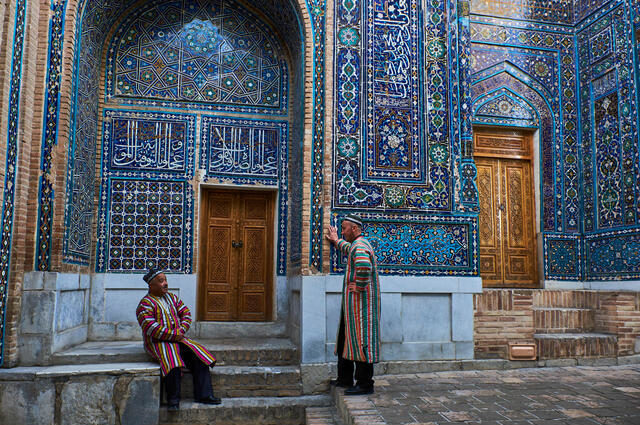
HISTORICAL OVERVIEW. THE TIMURID ERA
The arts and crafts of the 14th and 15th centuries represent a logical continuation of the aesthetics of the pre-Mongol era, with its strong emphasis on ornamentation. After overcoming the impact of the Mongol invasion, centers of pottery production were revived under Amir Timur’s state. Local clay was used for ceramics, including clay sourced from around Samarkand. Potters created a variety of pottery items.
The late 14th to early 15th centuries saw a remarkable surge in glazed ceramics. This period introduced a new type of ceramics — imitations of imported Chinese porcelain. Although local artisans were unaware of the technological secrets behind Chinese porcelain, they nonetheless achieved striking artistic effects. This ceramic ware became an export item, reaching as far as Europe, and was highly regarded by contemporaries.
Porcelain-like ceramics were produced in various cities across Central Asia and Iran. The “Chinese porcelain” style was among the most popular of this era, and at times, the creations of local artisans were indistinguishable from original Chinese porcelain. Exceptional examples of this blue-and-white ceramic style were crafted by artisans in Samarkand and Bukhara.
This period is marked by the formation and broad dissemination of the “Timurid ceramic style” across Central Asia, distinct from the ceramics of the previous period. In slightly modified forms, this style continued to thrive in the 16th and 17th centuries. During the Timurid era, a gradual transition took place from older to newer forms, with a prominent adoption of the blue color palette. In addition to the imitation pieces characteristic of the early phase, where local artisans replicated Far Eastern motifs and designs almost unchanged, later works began to incorporate creative improvisation. This innovation led to a new, syncretic ornamental style. On flat, round plates or shallow bowls, the ornamental artist would freely arrange images of birds, flowers, fantastical phoenixes, dragons, and roaming deer.
Thus, the distinguishing features of Timurid ceramics compared to the pre-Mongol period lay in its color scheme, ornamentation, and techniques. The vibrant, warm-toned style of 10th–12th century ceramics was replaced during the Timurid era by a more graphic design and a cooler color palette, reminiscent of porcelain. This included ceramics with a white background and blue painting, as well as blue-toned ceramics with black underglaze decoration.
While maintaining common aesthetic principles, the artistic style of 15th–16th century ceramics became more relaxed and expressive. During this period, ceramicists also produced architectural ceramics for facades, carved and stamped terracotta, tiles, glazed tiles, and painted majolica with vibrant, lasting colors that added unique decorative qualities to architectural monuments. The turquoise-blue palette, introduced into architectural spaces by ceramic artisans, became a symbolic expression of the Timurid era’s art. Unlike tableware, architectural ceramics were less influenced by Chinese artistic traditions, featuring primarily intertwined vegetal-geometric and epigraphic motifs.
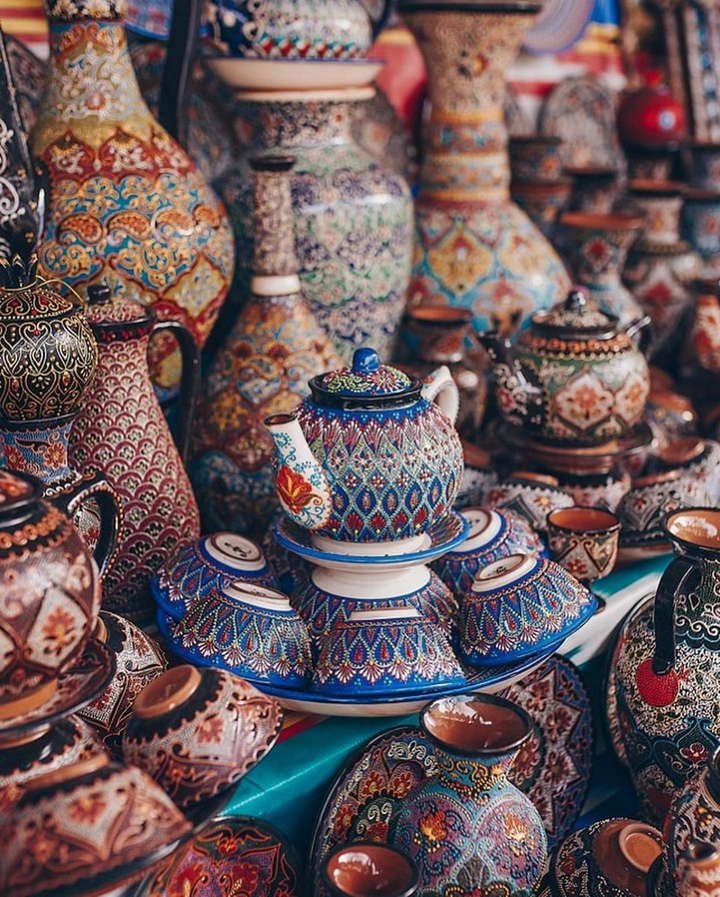
THE KHANATE PERIOD
The applied arts of the Uzbek Khanates — Bukhara, Khiva, and Kokand — did not reach the heights of the previous era. Their isolation led to insularity and an increasing localization of artistic processes. However, the crafts developed steadily, with artisans producing unique works based on traditional techniques and methods.
In ceramics, Timurid style traditions remained present, though the former elegance of ornamentation, forms, and high technological quality gradually diminished. The specialization within pottery was diverse — from form artisans to decorators — allowing for the creation of high-quality decorated pottery.
By the 19th century, the main schools and centers of glazed ceramics had been established in what is now Uzbekistan, each with rich historical traditions: (a) the central, or Samarkand-Bukhara school, with centers in Tashkent, Samarkand, Urgut, Bukhara, Gijduvan, Shakhrisabz, Kitab, Kattakurgan, and Denau; (b) the northeastern, or Ferghana school, with centers in Rishtan, Gurumsarai, and Andijan; and (c) the southwestern, or Khorezm school — located in Urgench, Khiva, Madir, and Kattabag villages. Each center’s ceramics, while following general developmental trends, retained unique local characteristics.
The ceramics of the Ferghana and Khorezm schools are distinguished by a cool blue-white color palette. This similarity in coloration is due to common technical practices — the use of potash or ishkor glazes, giving the underglaze patterns a specific blue hue. Beyond this, however — in the forms, content, and style of ornamentation — ceramics from these two schools differ significantly. Unique to Khorezm are the large badiya plates with raised vertical rims. The inner part of the badiya is typically decorated with a strict, symmetrical geometric design, which often transitions into flowing plant motifs, lending a dynamic aesthetic to Khorezmian ceramic ornamentation.
Ferghana school ceramics are more diverse in form and decorative motifs. These include large and medium-sized bowls, big plates, small jugs, vessels of various shapes for dairy storage, cups, handwashing vessels, and more. The ornamentation of Ferghana ceramics is finer and more intricate than that of Khorezmian pottery, creating a sense of intimacy. By the late 19th and early 20th centuries, Rishtan — a small town in the Ferghana Valley — produced the highest quality ceramics in terms of technical and artistic standards. Rishtan artisans developed their own painting style, infused with lyrical charm. Additionally, specific images, from jugs and musical instruments to guns and knives, began to appear in the ornamentation.
The Bukhara-Samarkand school of ceramics differs sharply in color from the blue-white ceramics of Ferghana and Khorezm, featuring a warm yellow-brown color palette, with decoration done in both brushwork and engraved patterns.
Uzbek artisans primarily crafted glazed (tableware) and unglazed ceramics (often for household purposes — large vessels for water and food storage). These items fell into two main shapes, bowl-like and jug-like, leading to specialization among craftsmen. The kosagar produced bowl-shaped items like kosa, shokosa, piyola, and flat plates; the kuzagar crafted variously shaped jugs and large water containers. Pottery was primarily wheel-thrown, though it was occasionally stamped or hand-molded. The forms were marked by simplicity and practicality. Common decoration methods for glazed items included brush painting and engraving on slip.
Another prominent center of Ferghana ceramics was Gurumsarai. Gurumsarai pottery is noted for its conservatism, adhering closely to traditional methods, with each item crafted entirely by a single artisan. The center’s relative isolation helped preserve certain traditional elements. The ornamentation of Gurumsarai ceramics features a limited range of motifs: jugs, four-leaf designs, cross patterns, and others.
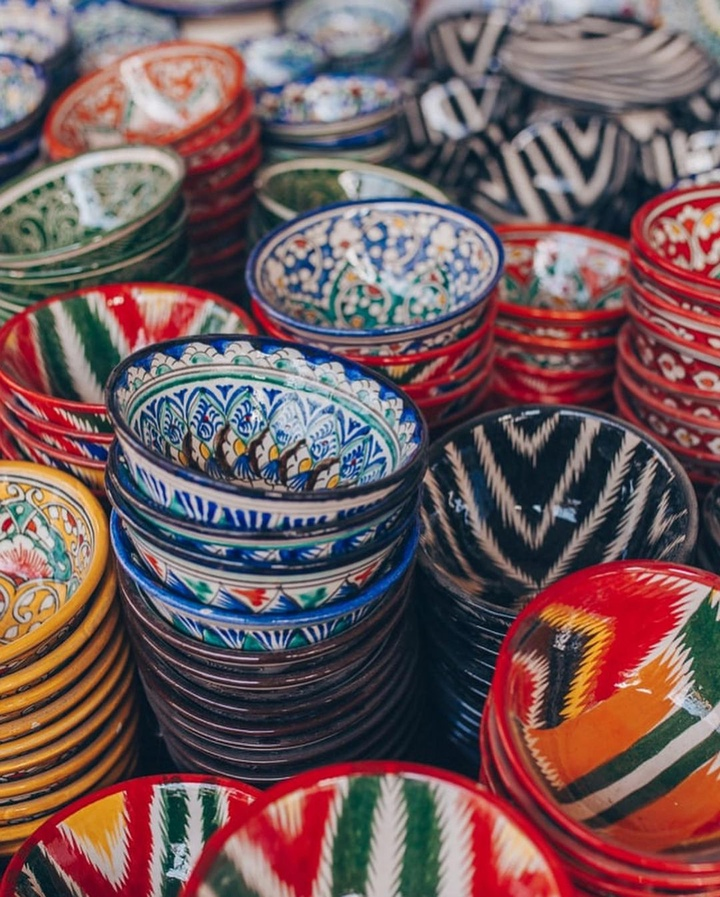
THE SOVIET PERIOD
In the 1950s and 1960s, ceramic production in Rishtan, Gijduvan, Shakhrisabz, Samarkand, Kattakurgan, Tashkent, as well as cities in the Surkhandarya, Kashkadarya, and Khorezm regions, maintained its unique forms, distinctive ornamental style, and original color palette.
However, from the 1960s onward, Uzbekistan’s glazed ceramics faced concerning trends, with many unique traditional pottery centers disappearing. This decline was largely driven by socio-economic factors. The situation worsened in the latter half of the 1980s, during the economic crisis that affected the USSR as a whole. As a result, the production of traditional glazed ceramics in Samarkand, Kattakurgan, Shakhrisabz, Kitab, and Tashkent nearly came to a halt.
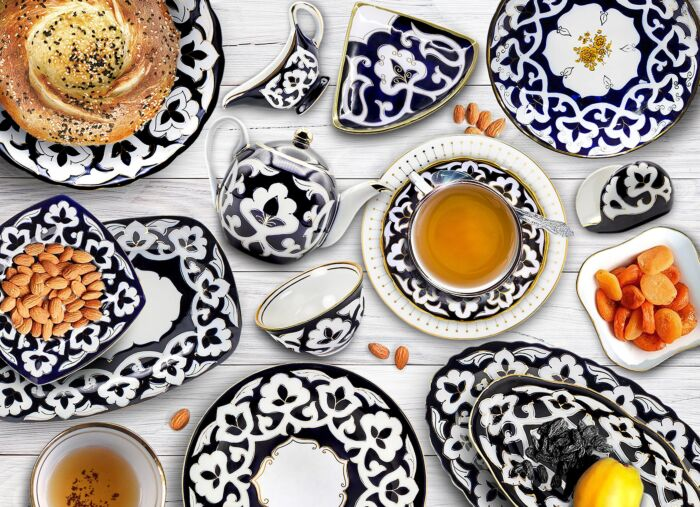
CONTEMPORARY PERIOD
The situation began to stabilize in 1993 when Uzbekistan achieved social and economic stability. Several government initiatives were implemented to create favorable conditions for the development of folk arts, including ceramics.
The ceramics from renowned centers have retained their distinct local artistic features. Artisans in Rishtan restored the traditional technique of using ishkor glaze (now utilized by all Rishtan craftsmen for decorating their wares) and brought back traditional forms. Today, Rishtan produces two main types of ceramic vessels: flat items (bowls, plates, etc.) and elongated forms (pitchers, hums, etc.). Some artisans craft both types, creating flat items and pitchers, vases, and more. Many middle-aged and younger artisans primarily focus on creating and decorating large flat plates known as lagans. Since the 1990s, some Rishtan artisans have incorporated Arabic calligraphy into the decoration of these flat plates, expanding their repertoire of techniques and ornamental patterns.
The shapes of Bukhara-Samarkand ceramics in the 1990s built upon the traditions of previous decades. Each center within the Bukhara-Samarkand school has its own distinctive approach to applying patterns. For example, artisans from Gijduvan and Shakhrisabz primarily use brush painting, while artisans from Urgut and Denau often employ engraved ornamentation. Unglazed ceramics are still used in rural areas for household purposes, such as large hums (storage vessels for food and water), tandir ovens for baking bread, and pitchers, crafted by artisans in various centers across Uzbekistan.
Khorezm potters have preserved the tradition of producing both tableware and architectural decorative elements. Khorezm ceramics are marked by a restrained and elegant style, reflecting the relative isolation of cultural development in this region, which preserved classical geometric ornamentation and a rich variety of plant motifs. The main centers of Khorezm ceramics today are the village of Madir near the district center of Khanka and the village of Kattabag near the district center of Yangiaryk.
International organizations play a significant role in reviving folk ceramics by providing grants to artisans to establish apprenticeship schools. The positive impact of these initiatives can be seen in the revival of the Gurumsarai and Gijduvan schools of traditional ceramics. Although the overall trend over the past century shows a reduction in the number of ceramic production centers, government efforts and support from international organizations in promoting traditional crafts bring hope for the restoration and development of the best traditions of Uzbek ceramic art.
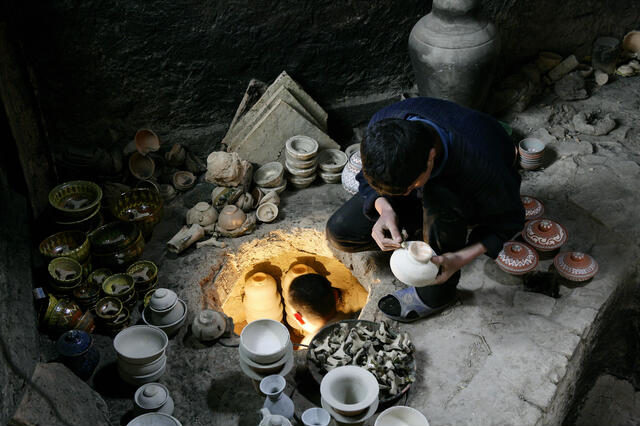
WORKSHOP EQUIPMENT AND TECHNOLOGY
The potter’s workshop was typically located within one of the rooms of the home or in an outdoor area adjacent to it. The kilns were almost always situated outside the main living quarters. The workshop’s primary piece of equipment was the potter’s wheel, which consisted of two wooden disks fixed onto a vertical axle. The lower part of the axle rested on a stone slab or log, while the upper part extended under the smaller, upper disk through a horizontal board. The potter sat in front of the wheel, spinning the lower disk with his feet, thereby rotating the upper disk. A lump of clay was placed on top, and the potter skillfully shaped it into the desired form as it spun. Occasionally, simple ornamentation was applied using a stick or the broken edge of a comb. Once the vessel was shaped, it was cut from the wheel with a knife or sickle and placed outside to dry. After drying, the vessel was decorated and glazed before going into the kiln for firing.
In addition to the potter’s wheel, the workshop was equipped with various iron cauldrons of different sizes for preparing glazes and pigments, a hand mill, a small mortar and pestle, a sieve, brushes for applying ornamentation, a knife, and a small spatula. Large water vessels, sometimes reaching a meter or more in height, were made without a potter’s wheel, crafted by hand through coiling and smoothing the clay with spatula strokes.
The same technique was used to make tandyrs (bread-baking ovens), which are a specialized branch of pottery. Tandyrs were crafted from pottery clay mixed with wool, shaped and smoothed with a special wooden paddle with a short handle. The tandyr consists of three sections, each of which is partially dried before stacking. The potter used one hand to press a tool resembling a rounded convex anvil made of fired clay against the seam while sealing it from the outside with a wooden spatula. Finished tandyrs were dried on-site for three to four days before they were ready for sale. They were typically sold at the local market, and each buyer would install it themselves.
Recommended Literature on the Topic (click to see the list)
- Aliyeva S. Artistic Glazed Ceramics of Uzbekistan from the 11th to the 20th Century. Tashkent, 2009.
- Belyaeva T. V. Artistic Ceramics of the 13th–19th Centuries. Medieval Urban Culture of Kazakhstan and Central Asia. Almaty, 1983.
- Veimarn B. V. Art of Central Asia. Moscow, Leningrad, 1940.
- Vorobyeva M. G. Khorezm Terracottas // Culture and Art of Ancient Khorezm. Moscow, 1981. pp. 185–194.
- Grazhankina N., Rakhimov M., Pletnev I. Architectural Ceramics of Uzbekistan. Tashkent, 1968.
- Denike B. Art of Central Asia. Moscow, 1927.
- Derviz G. Khakim Satimov and the Gurumsarai School of Traditional Folk Pottery. Series “Folk Craftsmen. Traditions, Schools”. Moscow, 1985.
- Derviz G., Zhadova L., Zhdanko I., Mityansky D. Contemporary Ceramics of Folk Artisans of Central Asia. Moscow, 1974.
- Lunina S. B. Forms of Specialization in Medieval Pottery Crafts of Central Asia // Soviet Archaeology. 1978, No. 3, pp. 127–136.
- Morozova A. S., Avedova N. A., Makhkamova S. M. Folk Decorative Art of Uzbekistan. Tashkent, 1979.
- Mukminova R. G. Essays on the History of Crafts in Samarkand and Bukhara in the 19th Century. Tashkent, 1976.
- Pugachenkova G. A. Samarkand Ceramics of the 15th Century // Archaeology of Central Asia. Tashkent, 1950. pp. 91–120.
- Pugachenkova G. A., Rempel L. I. History of Art in Uzbekistan. From Ancient Times to the Mid-12th Century. Moscow, 1965.
- Pugachenkova G. A., Rempel L. I. Essays on the History of Art in Central Asia. Moscow, 1982.
- Rakhimov M. K. Artistic Ceramics of Uzbekistan. Tashkent, 1961.
- Rempel L. I. Distant and Close: Pages of Life, Daily Life, Construction, Crafts, and Art of Old Bukhara. Tashkent, 1982.
- Rozvadovsky V. K. An Attempt to Study Pottery and Some Other Handicrafts in the Turkestan Region. Tashkent, 1916.
- Sayko E. V. History of Ceramic Craft Technology in Central Asia from the 8th to the 12th Centuries. Dushanbe, 1966.
- Tashkhodzhaev Sh. S. Artistic Glazed Ceramics of Samarkand from the 10th to Early 13th Century. Tashkent, 1967.
- Fakhretdinova D. A. Decorative and Applied Art of Uzbekistan. Tashkent, 1972.
- Khakimov A., Gül E. Baysun: Atlas of Crafts. Tashkent, 2006.
- Shishkina G. V. Glazed Ceramics of Sogd (Second Half of the 8th–13th Centuries). Tashkent, 1979.
- Shishkina G. V. Craft Production of Medieval Sogd // On the History of Glazed Ceramics Production. Tashkent, 1986.
- Culture and Art of Ancient Uzbekistan. Exhibition Catalog. Moscow, 1991.
- Cultural Heritage of Uzbekistan in World Collections. Series of Albums. Tashkent, 2020–2024.
- Folk Decorative Art of Soviet Uzbekistan. Tashkent, 1957.
- Folk Art of Uzbekistan. Album. Tashkent, 1978.
- The Uzbeks. Series “Peoples and Cultures”. Moscow, 2011.





